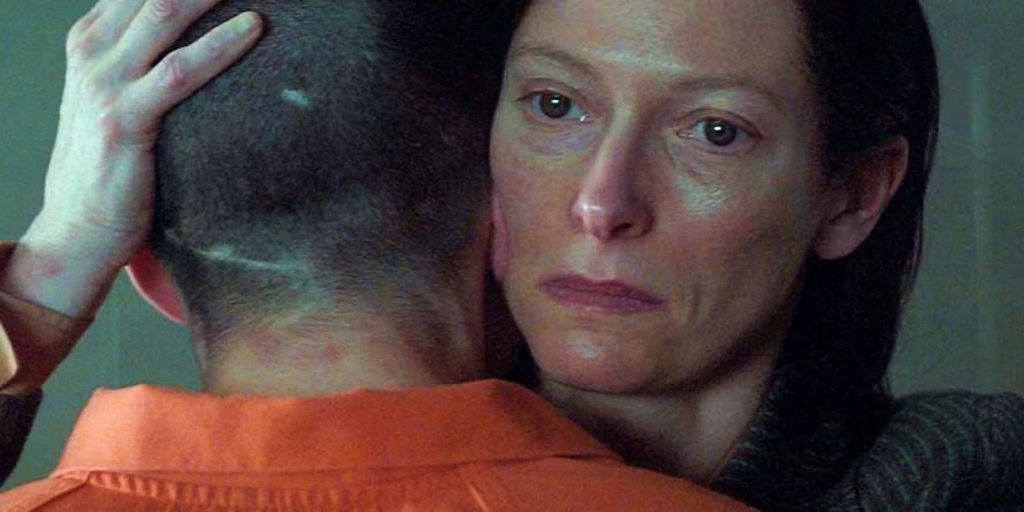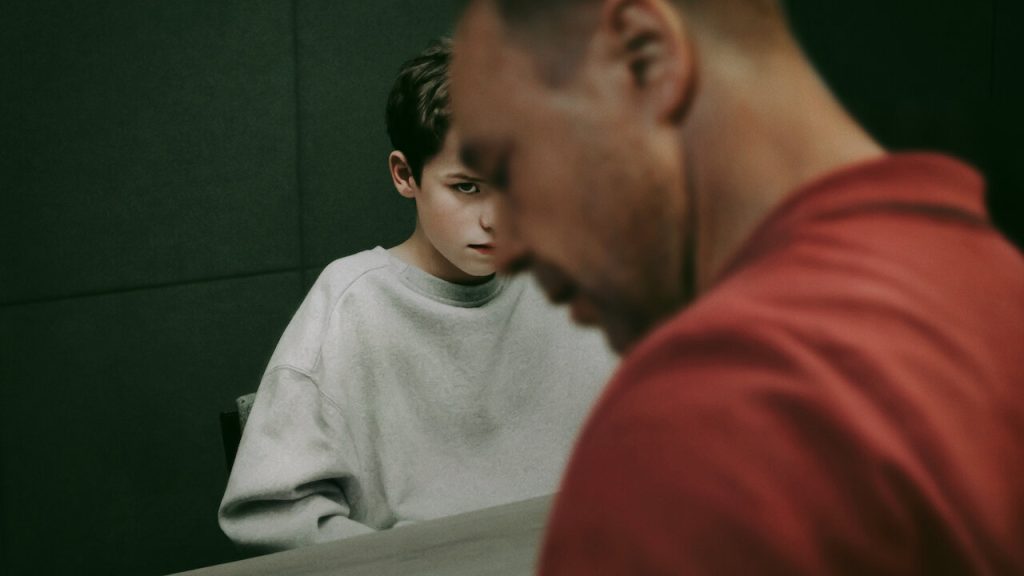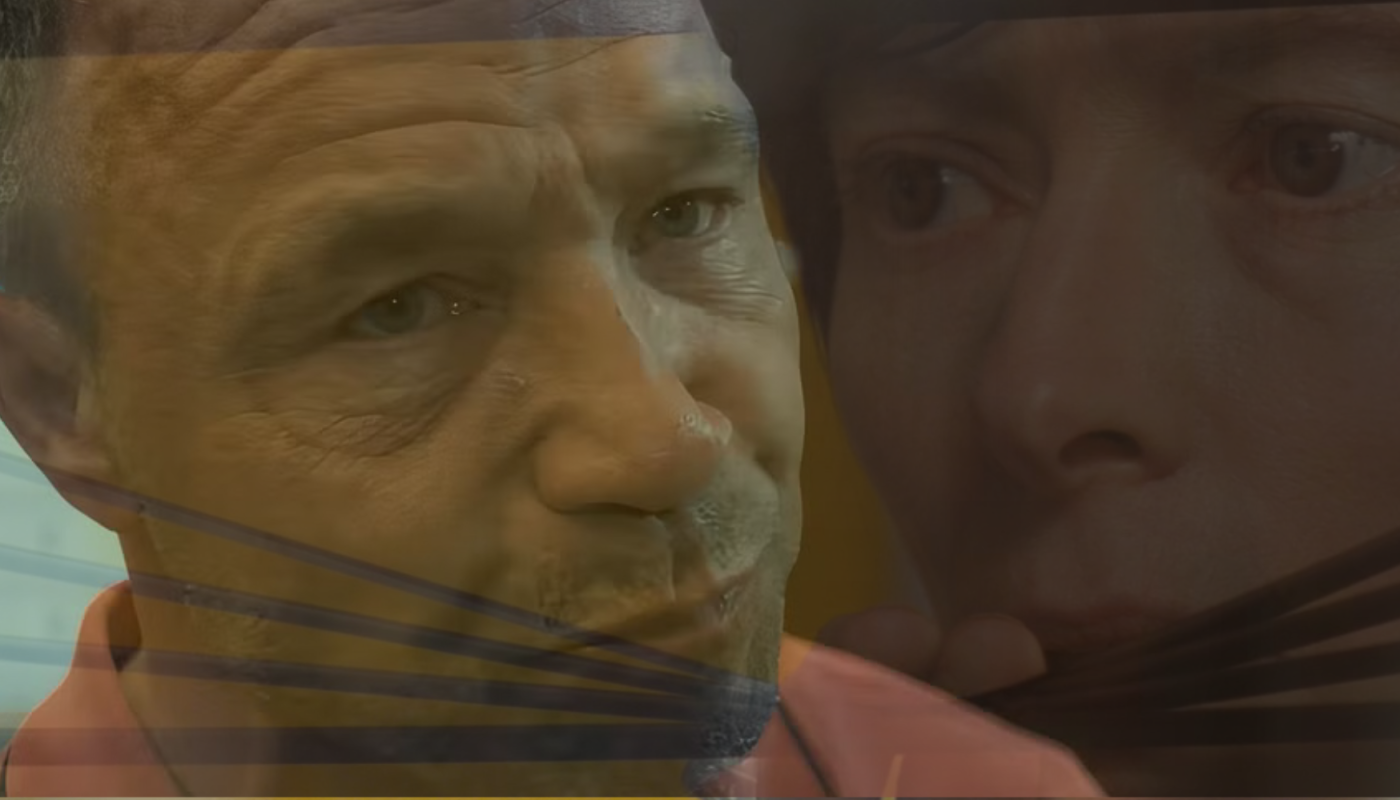Spoiler Alert! This article contains Spoilers of Adolescence and We Need to Talk About Kevin!!!
When I was watching “We Need to Talk About Kevin,” I kept thinking of the recently released Netflix show, “Adolescence”. I accidentally kept comparing both productions as the portrayal of a young murderer. They both try to explain each storyline as a “making a murder-esque” type of production. They’re trying to give us insight on what happened to those characters, what took them to commit their crimes, and most importantly, who are their parents, what are they like, and what influence did they have on them.
Summaries
Adolescence is a Netflix miniseries released in 2025, directed by Philip Barantini. It delves into the tragic events of a 13-year-old boy who kills his classmate. It explores themes of toxic masculinity, online radicalization, and familial grief.
The series centers on Jamie Miller (Owen Cooper). Apparently an ordinary teenager from a caring household, who is arrested for the brutal stabbing of his classmate, Katie. The story progresses as Jamie insists on his innocence until his culpability is revealed. After that, he goes to jail, meanwhile therapists are working with him, trying to understand his motivations. Simultaneously, his parents and his sister’s grief is explored as, confused, they tried to explain to themselves what went wrong.
Then it shows how Jamie had been influenced by misogynistic online communities, often referred to as the “manosphere.” After Katie publicly rejected his advances and labeled him an “incel” on social media, Jamie’s humiliation and internalized anger took him to his final act. The series ends with Jamie calling his parents telling them he wants to plead guilty, which devastates his family, especially his father, as they clinged to the last hope of his innocence. The series ends with a scene where Eddie Miller (Stephen Graham) enters Jamie’s bedroom and tucks his teddybear as he cries and apologizes, representing his profound guilt and helplessness.
We Need to Talk About Kevin is a 2011 psychological thriller film directed by Lynne Ramsay, based on Lionel Shriver’s novel. It explores the disturbing relationship between a mother and her increasingly psychopathic son, ending in a devastating crime.
The film follows Eva Khatchadourian (played by Tilda Swinton), a once-adventurous travel writer whose life becomes consumed by guilt and isolation after her teenage son, Kevin, commits a school massacre. The narrative is nonlinear between Eva’s current life as an outcast and flashbacks of Kevin’s childhood. From a young age, Kevin exhibits manipulative, cruel behavior, especially toward Eva. Despite her efforts to connect with him, he remains cold, controlling, and even violent. He often acts charming in front of others, especially his father,Franklin. Eva grows disturbed by his behavior, but her concerns are dismissed or minimized.
The tension escalates when Kevin blinds his little sister Celia’s eye with drain cleaner — an act he claims was accidental. Franklin still refuses to believe Kevin is dangerous.
The film climaxes with the reveal that Kevin carries out a meticulously planned massacre. He murders several classmates and teachers at his high school using a bow and arrow. He also kills his father and sister at home right before the school attack. In the end, Eva visits Kevin in prison as he is about to be transferred to an adult facility on his 18th birthday. For the first time, Kevin appears shaken and vulnerable. When Eva asks him why he did it, Kevin simply replies, “I used to think I knew. Now, I’m not so sure.” The film ends with Eva hugging her son before leaving the prison, hinting at a complicated gesture of forgiveness or, at least, a mother’s desperate attempt to hold on to a shred of meaning after trauma.

Comparison
Both productions portray two young boys who are disturbed, violent, aggressive, and ready to test limits and push those boundaries. They challenge their parents, their friends, or their classmates. Interesting enough, in both stories, the parents are innocent. In “Adolescence”, the premise of what originated Jamie’s violence is that he was pushed to the side by his parents, he was isolated and always by himself in his room consuming misogynistic and the “manosphere” content online. The series blames the development of Jaimie’s violence on sexist and aggressive online communities. The show even mentions the influencer charged with sex related offenses, Andrew Tate and delves on the morality spread by the famous “manosphere” surrounding women’s sexuality, women’s bodies, what makes a man strong, what makes a woman desirable and worth and what gives the right to men to abuse women in any way.
Note: “Adolescence touches on ‘incels’ – just like in The Boys– read more here”.
On the other hand, in We Need to Talk About Kevin, Kevin was always a rebellious child; he challenges his mother, has difficulty learning, and little by little explores the extremes of violence. He starts by yelling at and insulting his mom, he’s not obedient, he comments on his mother’s appearance, and even has sphincter issues. He poops his pants at an older age and on command to infuriate Eva and he does so to test how much control he has over her. When those acts of rebellion don’t suffice him anymore, he starts insulting his younger sister, Celia. Then he kills Celia’s hamster, and one day, he “accidentally” blinds her in one eye. Eva grows more and more concerned, but his father never seems to worry, even encourages him to practice with his bow and arrow. In the end, he kills his father and Celia before the school massacre he carried out. What interests me is why he didn’t kill his mom. Out of spite or because he only respected her. He spared her life but condemned her to pain and trauma for the rest of her days.
No matter how terrifying these stories seem, we must remember they’re not fully realistic. What makes them even more frightening is the fact that we believe this could very easily happen to us, but murderers aren’t that common, and they’re certainly not born just like that. Productions like these are great and captivating; they have great producers and directors, very skillful actors, and very good dramatic writers, but they lack nuance. Both productions lack a development and arc on how the environment and parents exacerbate their children’s aggression. In Adolescence, the influence of Jamie’s environment on his actions was loosely mentioned and completely reduced to mere post-modern social media-related problems. It was almost like your mom saying –“it’s because of that damn phone!”– every time something went wrong.
Both productions lack depth on the environment and how parents contribute to declining mental health. As viewers, we don’t want to believe that the problem comes from parents or deeply rooted trauma. It is easier for us to believe that some people are born mentally ill and we can’t control it. Not everyone is willing to accept the fact that, as part of a society and an environment, we can contribute to other people’s actions indirectly and carry partial responsibility. I’m not trying to confuse things and say that just because we live in a community, we are therefore responsible for other people’s actions, or other individuals’ actions, because we’re still individuals with separate thoughts and motivations. I believe that if we normalize and desensitize certain crimes, rates of such offenses will rise, especially if there aren’t punishments or consequences. We must increase awareness about how we contribute to our environment, social rules, and the things we consider acceptable. Often, we want to reduce every little issue anyone may have to the brain’s chemistry. However, we are social beings, and education, social constructions, and semiotics have an impact on our behaviors.

The million-dollar question: Are killers born or made?
Professor Adrian Raine’s neuroimaging studies of convicted murderers show patterns of brain abnormalities. Specifically, he found reduced activity in the prefrontal and heightened activity in the amygdala, which governs emotions. These imbalances, according to Raine, may come from early childhood abuse. The case of Donta Page exemplifies this: after facing years of brutal abuse by his mother, including being beaten with electrical cords and other objects, Page went on to commit a violent murder. Raine argues that such abuse can cause permanent physical damage to the brain, especially in areas critical to emotional regulation and moral judgment.
Still, Raine acknowledges that not every child subjected to abuse becomes a killer. This takes us to the question: Are there biological predispositions that, if combined with trauma, increase the risk of violent behavior?
For example, in a Dutch family with a history of male violence, researchers found a common denominator: they all lacked a properly functioning version of the MAOA gene. This gene regulates neurotransmitters that relate to impulse control. Individuals with a low-activity variant of the MAOA gene, especially when exposed to early life abuse, are more likely to have violent tendencies. As Professor Jim Fallon says, “If you’ve the high-risk form of the gene and you were abused early on in life, your chances of a life of crime are much higher.” (Fallon in BBC, 2015). However, it is important to consider that without environmental triggers like abuse, the same genetic predisposition may not lead an individual to become violent.
Recent studies go further by suggesting that psychopathy—strongly linked to violent crime and recidivism—is also genetically influenced. Research shows that genes impacting neurotransmitters such as dopamine, serotonin, and oxytocin are connected to personality and behavior, as demonstrated by twin studies where identical twins (sharing all genes) scored similarly on psychopathy measures (Brazil et al., 2024).
Nonetheless, genetic predisposition does not function in a vacuum. Environmental cues—such as parental neglect, unsafe neighborhoods, and hyper-competitive schools—can nurture psychopathic traits by rewarding manipulative and self-serving behavior. Brazil et al. (2024) argue that these signals condition adolescents to associate psychopathy with tangible rewards like social dominance or sexual success, particularly in male-dominated settings. This insight challenges the traditional notion of psychopaths as “broken” and reframes them as individuals using alternative, exploitative strategies to thrive in competitive environments.
Also, Dr. Rachael Sharman highlights a new societal variable: unsupervised digital environments. She argues that teenagers now navigate both real and online worlds, often without adequate adult oversight. The internet “manosphere,” for example, exposes vulnerable boys to aggressive ideologies that could encourage violent or misogynistic beliefs. While only a small number will act on these influences, they represent a modern risk factor not considered in earlier models of development.
I don’t believe someone like Eva or the Millers is entirely innocent. So, what can those parents do to prevent their kids from worsening? Or what are they doing wrong in the first place? In We Need to Talk About Kevin, for example, Eva was always aware of Kevin’s tendencies and rebellious behavior. Why was he never taken to a psychiatrist or therapist? Why did his parents never seek help, especially if they had the financial means?
There’s a scene where Kevin insults Eva for being fat, and she explains it’s because she’s pregnant. He replies, – “Is that when people fuck?”– this is a clear sign that Kevin was being exposed to sexualized information outside of his house at a very young age. But where and how?
Regarding Adolescence, I had previously underlined the phrase: “apologizes, representing his profound guilt and helplessness.” This reflects my issue with it. As much as I appreciate the show for its strong acting and drama, I insist it oversimplifies complex issues. How can a father suddenly have a violent 13-year-old capable of murdering a girl? At times, Eddie had some rage episodes that disrupted the household’s peace, but that wasn’t portrayed as a frequent behavior of his. Many people grow up with emotionally unavailable or unassertive parents, yet they don’t become murderers. Even those with psychopathic tendencies don’t always resort to violence unless they’re surrounded by it.
If stories like these were depicted as they should be—without being distorted for dramatic purposes—they could offer real insight. It’s important to reflect on how real-life stories are portrayed onscreen and to question the intentions behind them. These kinds of plots are great starting points for reflection and discussion, but they shouldn’t be taken literally, let alone treated as fact-based documentaries free from bias or logical fallacies.
As Ioan Grillo explains in Crashout Media, after working with youth violence in Baltimore, London, El Salvador, and Mexico, shows like Adolescence lack realism. He points out that most violent youth were exposed to gang culture and recruited at a very young age. I agree with his view that these shows can be “powerful calls to action” and “examples of art as activism”, but they should not be seen as documentaries. In the end, they are thrillers—nothing more, nothing less.
Bibliography :
BBC. (2015, March 6). The mind of a murderer. BBC News. https://www.bbc.com/news/magazine-31714853
Brazil, I. A., et al. (2024). Are psychopaths born or made? Psychology Today. https://www.psychologytoday.com/us/blog/understanding-the-evolution-of-behavior/202411/are-psychopaths-born-or-made
Sharman, R. (2025, March 25). Adolescence: Netflix show, teenage parenting advice. ABC News. https://www.abc.net.au/news/2025-03-25/adolescence-netflix-show-teenage-parenting-advice/105089848
Crashout Media. (2025, March 27). Adolescence is good TV but it’s unrealistic. https://www.crashoutmedia.com/p/adolescence-is-good-tv-but-its-unre






**mindvault**
Mind Vault is a premium cognitive support formula created for adults 45+. It’s thoughtfully designed to help maintain clear thinking
**mindvault**
mindvault is a premium cognitive support formula created for adults 45+. It’s thoughtfully designed to help maintain clear thinking
**sugarmute**
sugarmute is a science-guided nutritional supplement created to help maintain balanced blood sugar while supporting steady energy and mental clarity.
**gl pro**
gl pro is a natural dietary supplement designed to promote balanced blood sugar levels and curb sugar cravings.
**prostadine**
prostadine is a next-generation prostate support formula designed to help maintain, restore, and enhance optimal male prostate performance.
**prodentim**
prodentim an advanced probiotic formulation designed to support exceptional oral hygiene while fortifying teeth and gums.
**vitta burn**
vitta burn is a liquid dietary supplement formulated to support healthy weight reduction by increasing metabolic rate, reducing hunger, and promoting fat loss.
**glucore**
glucore is a nutritional supplement that is given to patients daily to assist in maintaining healthy blood sugar and metabolic rates.
**synaptigen**
synaptigen is a next-generation brain support supplement that blends natural nootropics, adaptogens
**nitric boost**
nitric boost is a dietary formula crafted to enhance vitality and promote overall well-being.
**wildgut**
wildgutis a precision-crafted nutritional blend designed to nurture your dog’s digestive tract.
**mitolyn**
mitolyn a nature-inspired supplement crafted to elevate metabolic activity and support sustainable weight management.
**zencortex**
zencortex contains only the natural ingredients that are effective in supporting incredible hearing naturally.
**yu sleep**
yusleep is a gentle, nano-enhanced nightly blend designed to help you drift off quickly, stay asleep longer, and wake feeling clear.
**breathe**
breathe is a plant-powered tincture crafted to promote lung performance and enhance your breathing quality.
**pineal xt**
pinealxt is a revolutionary supplement that promotes proper pineal gland function and energy levels to support healthy body function.
**energeia**
energeia is the first and only recipe that targets the root cause of stubborn belly fat and Deadly visceral fat.
**prostabliss**
prostabliss is a carefully developed dietary formula aimed at nurturing prostate vitality and improving urinary comfort.
**boostaro**
boostaro is a specially crafted dietary supplement for men who want to elevate their overall health and vitality.
**potentstream**
potentstream is engineered to promote prostate well-being by counteracting the residue that can build up from hard-water minerals within the urinary tract.
**hepatoburn**
hepatoburn is a premium nutritional formula designed to enhance liver function, boost metabolism, and support natural fat breakdown.
**hepato burn**
hepato burn is a potent, plant-based formula created to promote optimal liver performance and naturally stimulate fat-burning mechanisms.
**flow force max**
flow force max delivers a forward-thinking, plant-focused way to support prostate health—while also helping maintain everyday energy, libido, and overall vitality.
**prodentim**
prodentim is a forward-thinking oral wellness blend crafted to nurture and maintain a balanced mouth microbiome.
**cellufend**
cellufend is a natural supplement developed to support balanced blood sugar levels through a blend of botanical extracts and essential nutrients.
**neuro genica**
neuro genica is a dietary supplement formulated to support nerve health and ease discomfort associated with neuropathy.
**revitag**
revitag is a daily skin-support formula created to promote a healthy complexion and visibly diminish the appearance of skin tags.
**sleeplean**
sleeplean is a US-trusted, naturally focused nighttime support formula that helps your body burn fat while you rest.
**memorylift**
memorylift is an innovative dietary formula designed to naturally nurture brain wellness and sharpen cognitive performance.
If you’re a slot fanatic like me, check out we88slot. They have a killer selection of games – everything from the classics to the newest releases. I’ve already spent hours on there and won some decent cash. Def recommend giving it a try: we88slot